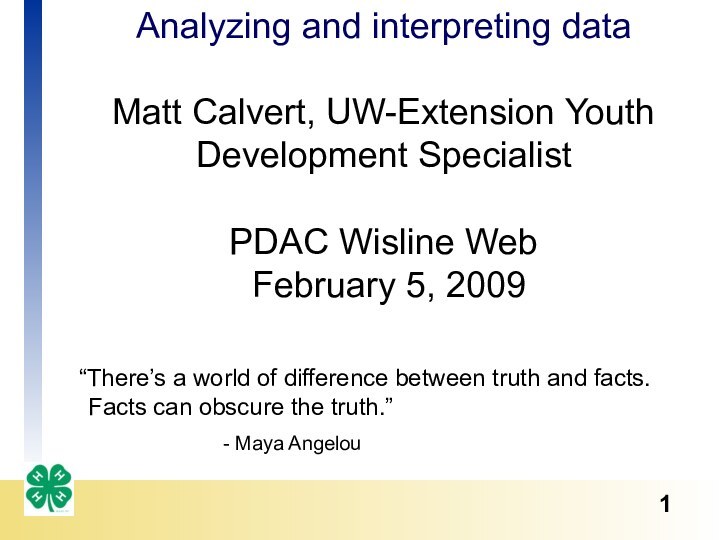- Главная
- Разное
- Бизнес и предпринимательство
- Образование
- Развлечения
- Государство
- Спорт
- Графика
- Культурология
- Еда и кулинария
- Лингвистика
- Религиоведение
- Черчение
- Физкультура
- ИЗО
- Психология
- Социология
- Английский язык
- Астрономия
- Алгебра
- Биология
- География
- Геометрия
- Детские презентации
- Информатика
- История
- Литература
- Маркетинг
- Математика
- Медицина
- Менеджмент
- Музыка
- МХК
- Немецкий язык
- ОБЖ
- Обществознание
- Окружающий мир
- Педагогика
- Русский язык
- Технология
- Физика
- Философия
- Химия
- Шаблоны, картинки для презентаций
- Экология
- Экономика
- Юриспруденция
Что такое findslide.org?
FindSlide.org - это сайт презентаций, докладов, шаблонов в формате PowerPoint.
Обратная связь
Email: Нажмите что бы посмотреть
Презентация на тему Ffff
Содержание
- 2. True or False?Complex analysis impresses people.I am
- 3. Data analysis and interpretationThink about analysis EARLYStart
- 4. Why do I need an analysis plan?To
- 5. Key components of a data analysis planPurpose
- 6. Analyzing and Interpreting Quantitative DataQuantitative Data isPresented
- 7. True or False?Quantitative data we gather in
- 8. Analyzing Survey DataDo you want to report…
- 9. Common descriptive statisticsCount (frequencies)PercentageMeanModeMedianRangeStandard deviationVarianceRanking
- 10. Other StatisticsStatistical SignificanceFactor AnalysisEtc.Not often used in
- 11. Getting your data readyAssign a unique identifierOrganize
- 12. Data entryYou can enter your data By handBy computerhttp://learningstore.uwex.edu/Using-Excel-for-Analyzing-Survey-Questionnaires-P1030C0.aspx
- 13. Data entry by computerBy Computer Excel (spreadsheet)Microsoft
- 14. Data entry computer screenSmoking: 1 (YES) 2 (NO)
- 15. Dig deeperDid different groups show different results?Were
- 16. Supports restaurant ordinanceOpposes restaurant ordinanceUndecided/ declined to
- 17. Pre-post or post-then-pre DataCheck data—any individual not
- 18. Interpretation of Pre/Post DataWhich statement is the
- 19. Discussing limitationsWritten reports: Be explicit about your
- 20. Analyzing and Interpreting Qualitative DataQualitative data is
- 21. QuizData have their own meaningQualitative analysis is easier than quantitative analysis
- 22. Analyzing qualitative data“Content analysis” steps: Transcribe data
- 23. Hand coding qualitative data
- 24. Emergent or pre-conceived categories?Consider this section—what themes emerge related to arts and communications programs?
- 25. Focus group sampleQ. How are the arts/comm.
- 26. Using theories and categoriesConsider this section again—how
- 27. Ensuring Validity in Qualitative AnalysisBe systematicUse multiple
- 28. Скачать презентацию
- 29. Похожие презентации
True or False?Complex analysis impresses people.I am generally able to analyze and interpret the program data I gather




























Слайд 3
Data analysis and interpretation
Think about analysis EARLY
Start with
a plan
Code, enter, clean
Analyze
Interpret
Reflect
What did we learn?
What conclusions can
we draw?What are our recommendations?
What are the limitations of our analysis?
Слайд 4
Why do I need an analysis plan?
To make
sure the questions and your data collection instrument will
get the information you want.To align your desired “report” with the results of analysis and interpretation.
To improve reliability--consistent measures over time.
Слайд 5
Key components of a data analysis plan
Purpose of
the evaluation
Questions
What you hope to learn from the question
Analysis
technique How data will be presented
Слайд 6
Analyzing and Interpreting Quantitative Data
Quantitative Data is
Presented in
a numerical format
Collected in a standardized manner
e.g. surveys, closed-ended
interviews, testsAnalyzed using statistical techniques
Слайд 7
True or False?
Quantitative data we gather in Extension
are more generalizable than qualitative data.
Stating limitations weakens the
evaluation
Слайд 8
Analyzing Survey Data
Do you want to report…
how
many people answered a, b, c, d?
the average number
or score?a change in score between two points in time?
how people compared?
how many people reached a certain level?
Слайд 9
Common descriptive statistics
Count (frequencies)
Percentage
Mean
Mode
Median
Range
Standard deviation
Variance
Ranking
Слайд 10
Other Statistics
Statistical Significance
Factor Analysis
Etc.
Not often used in Extension
program evaluation—generally require randomization, large samples, and/or control groups
Слайд 11
Getting your data ready
Assign a unique identifier
Organize and
keep all forms (questionnaires, interviews, testimonials)
Check for completeness and
accuracyRemove those that are incomplete or do not make sense
Слайд 12
Data entry
You can enter your data
By hand
By
computer
http://learningstore.uwex.edu/Using-Excel-for-Analyzing-Survey-Questionnaires-P1030C0.aspx
Слайд 13
Data entry by computer
By Computer
Excel (spreadsheet)
Microsoft Access
(database mngt)
Quantitative analysis: SPSS (statistical software)
Qualitative analysis: Epi info
(CDC data management and analysis program: www.cdc.gov/epiinfo); In ViVo, etc.
Слайд 15
Dig deeper
Did different groups show different results?
Were there
findings that surprised you?
Are there things you don’t understand
very well – further study needed?
Слайд 16
Supports restaurant ordinance
Opposes restaurant ordinance
Undecided/ declined to comment
Current
smokers
(n=55)
8
(15% of smokers)
33
(60% of smokers)
14
(25% of smokers)
Non-smokers
(n=200)
170
(86% of non-smokers)
16
(8% of non-smokers)
12
(6% of non-smokers)
Total
(N=255)
178
(70% of all respondents)
49
(19% of all respondents)
26
(11% of all respondents)
Слайд 17
Pre-post or post-then-pre Data
Check data—any individual not responding
to both pre and post should be discarded
Decide:
Report
individual change or combined change?Compare to a standard?
See PD&E Evaluation Quick Tip 30
Слайд 18
Interpretation of Pre/Post Data
Which statement is the most
significant to you?
The number of club officers reporting strong
or very strong knowledge of parliamentary procedure increased from 4 (50%) to 6 (75%).The number of club officers reporting at least some knowledge of parliamentary procedure increased from 5 (63%) to 8 (100%).
50% of the 8 participants reported an increase in their knowledge of parliamentary procedure.
Self-reports of knowledge of parliamentary procedure on a scale from 1=minimal to 4=very strong averaged 2.375 before the training and 3.0 after.
Rate your knowledge of parliamentary procedure : 1=minimal 2=some 3=strong 4=very strong
Слайд 19
Discussing limitations
Written reports:
Be explicit about your limitations
Oral
reports:
Be prepared to discuss limitations
Be honest about limitations
Know
the claims you cannot makeDo not claim causation without a true experimental design
Do not generalize to the population without random sample and quality administration (e.g., <60% response rate on a survey)
Слайд 20
Analyzing and Interpreting Qualitative Data
Qualitative data is thick
in detail and description.
Data often in a narrative format
Data
often collected by observation, open-ended interviewing, document reviewAnalysis often emphasizes understanding phenomena as they exist, not following pre-determined hypotheses
Слайд 22
Analyzing qualitative data
“Content analysis” steps:
Transcribe data (if
audio taped)
Read transcripts
Highlight quotes and note why important
Code quotes
according to margin notesSort quotes into coded groups (themes)
Interpret patterns in quotes
Describe these patterns
Слайд 24
Emergent or pre-conceived categories?
Consider this section—what themes emerge
related to arts and communications programs?
Слайд 25
Focus group sample
Q. How are the arts/comm. Activities
different from other projects?
When I was little, fair was
never that exciting to me. I didn’t realize how much else there was to do. It’s shown me how many different things you could do and get money for it, so you can’t go wrong.Art projects are more personal. It’s more of an expression of yourself. Where with an animal, you just show the animal off. With art, you show you can do something good.
(lots of agreement with this).
Q. What about A&C helps with communication?
You’re forced into the situations. A lot of clubs require demonstrations. The first year, everyone encouraged me just to talk.
To have someone push you along the way helps.
In a 4-H Club, you get to be friends. It’s more like family.
If you’re ticked off at your family, you can go up to your room and draw. Feel better.
It feels more comfortable because you’re not the only one. People at school say, “she’s an arts nerd.” You can relate to them. And even they’re so diverse. You cram people in and say you’ve got to get along.
With school, you only go part of the year. With 4-H, it’s all year a few times a month. At school, it’s every single day. It’s too much.
Q. How have you been changed?
Entering art in fair has made me not worry so much about what other people think about my work. I’ll take into consideration what they say, but most of it’s opinion. They can have their own style through photography and I can have mine through sketching.
I think it depends on the suggestion. I usually consider it a lot and it might help me or it might not.
It’s always there in the back of your mind at least.
It’s your own style. If people say, you could change this, I can say thank you for your input, but I’m not worried.
Q. How is 4-H different from other school and community experiences?
Working with people from all over the state and bring their ideas back. Also, how they’re doing the Madison cow parade. I wouldn’t have even heard about that. This year I have one of the micro-cows that was selected.
School is an assignment. You have to do that project. Where 4-H you can do any kind of art, any way you want to do it.
But at school, you can also exhibit. You can get opinions from an art teacher like from a judge. It’s not that different except that you can do what you want.
Although you do learn a lot of techniques from school that you might not learn from 4-H.
Слайд 26
Using theories and categories
Consider this section again—how are
arts and communication programs providing the 4 Essential Elements?
Generosity
Opportunity to value and practice service for othersBelonging An inclusive environment and safe environment
Independence Opportunity to see oneself as an active participant in the future; Opportunity for self-determination
Mastery Engagement in Learning and Opportunity for Mastery
Слайд 27
Ensuring Validity in Qualitative Analysis
Be systematic
Use multiple raters
Attend
to context (e.g. keep track of who said what)
Account
for outlying and surprising statementsTriangulate





























